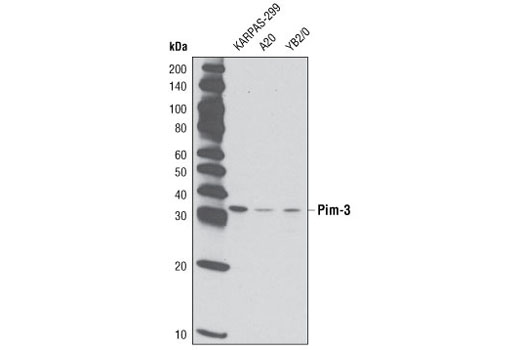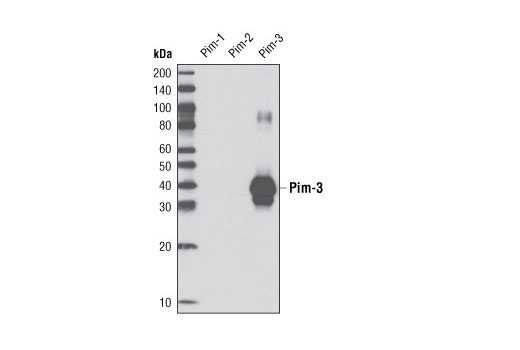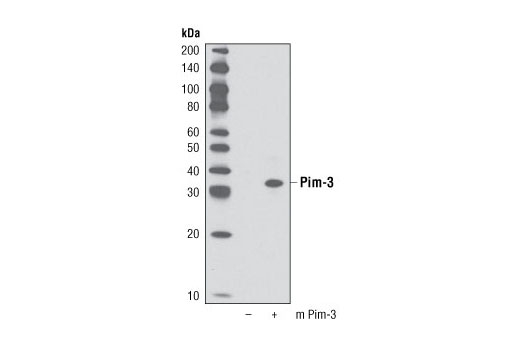WB
H M R
Endogenous
35
Rabbit IgG
#Q86V86
415116
Product Information
Product Usage Information
| Application | Dilution |
|---|---|
| Western Blotting | 1:1000 |
Storage
Specificity / Sensitivity
Species Reactivity:
Human, Mouse, Rat
Species predicted to react based on 100% sequence homology
The antigen sequence used to produce this antibody shares
100% sequence homology with the species listed here, but
reactivity has not been tested or confirmed to work by CST.
Use of this product with these species is not covered under
our
Product Performance Guarantee.
Monkey
Source / Purification
Monoclonal antibody is produced by immunizing animals with a synthetic peptide corresponding to residues surrounding Ser275 of human Pim-3.
Background
Pim proteins (Pim-1, Pim-2 and Pim-3) are oncogene-encoded serine/threonine kinases (1). Pim-1, a serine/threonine kinase highly expressed in hematopoietic cells, plays a critical role in the transduction of mitogenic signals and is rapidly induced by a variety of growth factors and cytokines (1-4). Pim-1 cooperates with c-Myc in lymphoid cell transformation and protects cells from growth factor withdrawal and genotoxic stress-induced apoptosis (5,6). Pim-1 also enhances the transcriptional activity of c-Myb through direct phosphorylation within the c-Myb DNA binding domain as well as phosphorylation of the transcriptional coactivator p100 (7,8). Hypermutations of the Pim-1 gene are found in B-cell diffuse large cell lymphomas (9). Phosphorylation of Pim-1 at Tyr218 by Etk occurs following IL-6 stimulation and correlates with an increase in Pim-1 activity (10). Various Pim substrates have been identified; Bad is phosphorylated by both Pim-1 and Pim-2 at Ser112 and this phosphorylation reverses Bad-induced cell apoptosis (11,12).
Pim-3, originally named Kid-1, was identified as a protein induced by depolarization in PC-12 cells (13). Like other family members, Pim-3 can phosphorylate Bad to inhibit Bad-mediated apoptosis (14). Aberrant expression of Pim-3 has been observed in a number of types of cancer, including liver, pancreas, colon and gastric cancer (14-17).
- Mikkers, H. et al. (2004) Mol Cell Biol 24, 6104-15.
- Selten, G. et al. (1986) Cell 46, 603-11.
- Meeker, T.C. et al. (1987) J Cell Biochem 35, 105-12.
- Dautry, F. et al. (1988) J Biol Chem 263, 17615-20.
- Möröy, T. et al. (1993) Proc Natl Acad Sci USA 90, 10734-8.
- Lilly, M. and Kraft, A. (1997) Cancer Res 57, 5348-55.
- Leverson, J.D. et al. (1998) Mol Cell 2, 417-25.
- Winn, L.M. et al. (2003) Cell Cycle 2, 258-62.
- Pasqualucci, L. et al. (2001) Nature 412, 341-6.
- Kim, O. et al. (2004) Oncogene 23, 1838-44.
- Aho, T.L. et al. (2004) FEBS Lett 571, 43-9.
- Yan, B. et al. (2003) J Biol Chem 278, 45358-67.
- Feldman, J.D. et al. (1998) J Biol Chem 273, 16535-43.
- Li, Y.Y. et al. (2006) Cancer Res 66, 6741-7.
- Fujii, C. et al. (2005) Int J Cancer 114, 209-18.
- Popivanova, B.K. et al. (2007) Cancer Sci 98, 321-8.
- Zheng, H.C. et al. (2008) J Cancer Res Clin Oncol 134, 481-8.
Species Reactivity
Species reactivity is determined by testing in at least one approved application (e.g., western blot).
Western Blot Buffer
IMPORTANT: For western blots, incubate membrane with diluted primary antibody in 5% w/v BSA, 1X TBS, 0.1% Tween® 20 at 4°C with gentle shaking, overnight.
Applications Key
WB: Western Blotting
Cross-Reactivity Key
H: human M: mouse R: rat Hm: hamster Mk: monkey Vir: virus Mi: mink C: chicken Dm: D. melanogaster X: Xenopus Z: zebrafish B: bovine Dg: dog Pg: pig Sc: S. cerevisiae Ce: C. elegans Hr: horse GP: Guinea Pig Rab: rabbit All: all species expected
Trademarks and Patents
使用に関する制限
法的な権限を与えられたCSTの担当者が署名した書面によって別途明示的に合意された場合を除き、 CST、その関連会社または代理店が提供する製品には以下の条件が適用されます。お客様が定める条件でここに定められた条件に含まれるものを超えるもの、 または、ここに定められた条件と異なるものは、法的な権限を与えられたCSTの担当者が別途書面にて受諾した場合を除き、拒絶され、 いかなる効力も効果も有しません。
研究専用 (For Research Use Only) またはこれに類似する表示がされた製品は、 いかなる目的についても FDA または外国もしくは国内のその他の規制機関により承認、認可または許可を受けていません。 お客様は製品を診断もしくは治療目的で使用してはならず、また、製品に表示された内容に違反する方法で使用してはなりません。 CST が販売または使用許諾する製品は、エンドユーザーであるお客様に対し、使途を研究および開発のみに限定して提供されるものです。 診断、予防もしくは治療目的で製品を使用することまたは製品を再販売 (単独であるか他の製品等の一部であるかを問いません) もしくはその他の商業的利用の目的で購入することについては、CST から別途許諾を得る必要があります。 お客様は以下の事項を遵守しなければなりません。(a) CST の製品 (単独であるか他の資材と一緒であるかを問いません) を販売、使用許諾、貸与、寄付もしくはその他の態様で第三者に譲渡したり使用させたりしてはなりません。また、商用の製品を製造するために CST の製品を使用してはなりません。(b) 複製、改変、リバースエンジニアリング、逆コンパイル、 分解または他の方法により製品の構造または技術を解明しようとしてはなりません。また、 CST の製品またはサービスと競合する製品またはサービスを開発する目的で CST の製品を使用してはなりません。(c) CST の製品の商標、商号、ロゴ、特許または著作権に関する通知または表示を除去したり改変したりしてはなりません。(d) CST の製品をCST 製品販売条件(CST’s Product Terms of Sale) および該当する書面のみに従って使用しなければなりません。(e) CST の製品に関連してお客様が使用する第三者の製品またはサービスに関する使用許諾条件、 サービス提供条件またはこれに類する合意事項を遵守しなければなりません。


